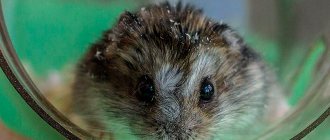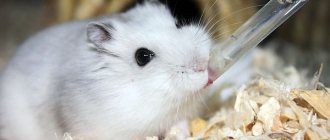Hamsters are quite popular pets, which seem to be completely unpretentious and do not require much of your time or careful care. In some ways this is true, hamsters do not require as much attention as, for example, dogs. But you need to take care of hamsters regularly and very carefully, monitoring what they eat and the conditions in which they live. Otherwise, you may encounter health problems with your pet. In this article we will talk about eye diseases of these animals. Why do hamsters have red eyes? Why do they turn sour or become bulging? How to recognize the first symptoms and how to treat the animal in order to destroy the source of the disease as quickly as possible.
Main Causes of Eye Diseases in Hamsters
Hamsters are quite sensitive to various types of infections, and they are also often affected by senile illnesses. Conventionally, the main causes of eye diseases can be divided into several categories:
- Unsanitary living conditions. Hamsters often need to clean their house and change their bedding because harmful microorganisms easily multiply in it. We all know how hamsters love to bury their heads, so it's not surprising that they can easily get an eye infection.
- Eye injuries. Quite often, an animal can damage its eye with a sharp object, stab or hit itself with something. As a result, the hamster's eye becomes swollen, or begins to water and turn red.
- Allergic reactions. Hamsters can have allergic reactions to certain foods, or even to cleaning products you use to mop the floor or clean the animal's cage.
- As a result of other diseases. If your hamster has had a certain viral disease, this may result in conjunctivitis or other bacterial infections. This is caused by decreased immunity.
- Age-related diseases. When an animal reaches natural old age, eye problems may appear. In particular, these are white spots that cover a significant part of the eye.
Not only old hamsters, but also very young hamsters can get eye problems. In order to prevent a possible disease in time, you need to consult a veterinarian at the first symptoms, who will prescribe the most effective treatment, because not every problem can be treated with the same methods of treatment.
Non-inflammatory diseases
Cataract
If your hamster's eye is cloudy, it could be a cataract - a metabolic disorder in the lens. The disease leads to
blindness. Eye drops are not effective, and surgery is not performed in either the Djungarian or the larger Syrian hamster. When the owner notices that the hamster's eye has turned white, this is a reason to consult a doctor, despite the fact that there is no treatment. Cataracts in a hamster are a sign of old age, decrepitude of the body, and in a dwarf or Campbell's hamster it is an indirect sign of diabetes. In both cases, treatment of the underlying disease is required to prolong the pet's life.
A thorn on the surface of the cornea is not a cataract, but the consequences of an injury, a scar. With cataracts, something light is visible in the depths, in the area of the pupil.
Glaucoma
An increase in intraocular pressure is accompanied not only by enlargement and bulging of the eyeballs, but also by severe pain. A doctor makes a diagnosis of glaucoma after measuring the pressure in the eye. It is not possible to normalize it with drops; the only treatment is enucleation to stop the pain. If you don't do anything, the eye will eventually burst. It is difficult to say why such a pathology occurs. Since Campbell's hamsters are most often affected, rarely Djungarians and never Syrians, a genetic (hereditary) nature is assumed.
Oncology
A small bump on a hamster's eyelid may be a tumor. Oncology can also be the reason why one eye suddenly becomes larger than the other. Ornamental rodents are susceptible to cancer and there is no effective treatment in such cases.
Conjunctivitis in hamsters: symptoms and treatment methods
Conjunctivitis is a familiar problem to everyone, but it affects not only people, but also pets. It needs to be treated at the first symptoms, because in a neglected state many more serious sores can be added, some of which can only be solved by surgical intervention.
The first symptom of conjunctivitis is considered to be wet eyes, then more serious troubles are added, such as:
- The hamster's eyes fester, the pus is characteristically green or yellow, especially in large quantities in the morning;
- The eyelids swell;
- The animal cannot fully open its eyes;
- The hamster becomes lethargic and refuses to eat.
Usually, for conjunctivitis, the veterinarian prescribes washing and instillation of the eyes with special drops. Also, a sick animal needs to be subject to some kind of quarantine. Isolate him from other animals that live in your home.
Additional tips regarding treating conjunctivitis in hamsters:
- Careful hygiene. Change the bedding daily, and wash your hands before putting drops in the animal’s eyes;
- Both eyes need to be treated, even if only one is sick;
- Monitor your pet's diet, excluding sweets;
Usually, conjunctivitis can be completely cured in two to three weeks. To avoid re-infection, try to keep the animal's cage clean and play with it after washing your hands.
It is important to know that untimely treatment of this infection can lead to your hamster's eye popping out. It will become unnaturally convex. This can only be corrected through surgery.
If it doesn't open
Only the attending physician - a veterinarian - can help establish the correct diagnosis. Therefore, if the hamster’s eyes do not open, you urgently need to take your pet and take it for examination.
If for some reason you are currently unable to visit a veterinarian, you will need to do the following:
- A hamster whose eyes are sour, inflamed and completely closed should be quarantined, that is, separated from his fellow cagemates.
- The animal’s home, as well as all accessories that are in it, must be disinfected (a solution of potassium permanganate or soda solution can be used as an antiseptic).
- At home, you can drip a rodent's eye with special Albucid drops, which are sold in any pharmacy. You need to drip every day so that your hamster's inflamed and swollen eyelids fully open.
But before instilling this medicine, you need to treat the inflamed area with saline solution. Soak a cotton swab in the warm solution and drop it onto the inflamed area. In the absence of saline solution, you can use ordinary boiled water. Its temperature should not be higher than room temperature. With suppuration, bleeding and protrusion of the organs of vision in hamsters, the drug “Tsiprovet” helps very well.
Eye diseases associated with aging changes in the body
Very often, with age, hamsters develop such an unpleasant disease as cataracts. It manifests itself as white spots, clouding of the lens, and blurred vision. The animal gets really stressed because it begins to see poorly. Unfortunately, this disease can rarely be cured; all that remains is to make the animal’s life as easy as possible by following certain tips:
- Do not place the hamster's cage in direct sunlight, this will further irritate the eyes and worsen the situation;
- Don't give your animal a lot of sweets. In return, give a lot of carrots and zucchini.
- Do not place many objects in the cage, because due to poor eyesight the animal may hit them and injure itself.
This is all you can do for your pet to somehow make his life easier.
Bacterial and viral diseases of the hamster
Hamsters are very susceptible to diseases caused by pathogenic microorganisms, viruses, and bacteria. Infection is possible by contact, aerogenous, nutritional means, or by eating low-quality feed. Some diseases of bacterial etiology can be transmitted to hamsters from humans and other pets.
Colibacillosis
The infection is caused by Escherichia coli, which parasitizes the gastrointestinal tract of animals. This disease of dzhungarik is also known as “wet tail”, as the sore is manifested by severe diarrhea.
Other symptoms of colibacillosis include:
- decreased, lack of appetite;
- weight loss;
- restless behavior;
- depression, lethargy, apathy;
- drowsiness;
- the presence of wet fur near the anus.
Hamster stool with diarrhea has a watery consistency. The hamster constantly curls up into a ball, hides in secluded places in the cage, and looks untidy.
The disease is characterized by an aggressive course and spreads very quickly, therefore, when keeping several animals together in a cage, you must immediately move the sick pet to another home. The disease can be cured only in the early stages of development.
Diplococcosis
An infection of the respiratory tract caused by round microscopic bacteria called diplococci. The main symptoms are lethargy, apathy, decreased activity, discharge from the nose and eyes. If the infection is severe, the dzhungarik refuses food and treats.
The disease requires immediate treatment using special serums. If therapy is not started, the pet’s death occurs on the second or third day.
Salmonellosis
The disease is caused by pathogenic rod-shaped microorganisms - salmonella. With this infection, hamsters experience foamy diarrhea, weakness, apathy, and pale mucous membranes.
A sick hamster refuses food, hides in a dark corner, sits motionless, showing no interest in the world around it. The rodent's tummy is enlarged.
In the stool you may notice bloody clots, threads, particles of undigested food, and mucus.
Viral pneumonia
The disease develops against the background of weakened resistance and weakened immune potential. Prolonged hypothermia, chronic otitis, hypo-, avitaminosis can also cause the development of viral pneumonia in animals.
The disease is manifested by abundant mucous, mucopurulent discharge from the eyes, nose, refusal to feed, coughing attacks, and shortness of breath. The hamster has a wet muzzle, hoarse, rapid breathing, and pale mucous membranes. If he shakes his head, his ear, wax has accumulated in the ears, there are crusts and an unpleasant odor emanates, most likely the animal is sick with otitis media, the cause of which is a respiratory illness.
Pneumonia develops against the background of ophthalmological diseases or can provoke eye and ear diseases. With timely treatment, the hamster recovers completely within a week.
Aujeszky's disease
Pseudorabies is a deadly viral disease. The disease manifests itself as severe nervous disorders. The hamster becomes restless and may show aggression. Attacks of excitement are replaced by complete apathy. A sick pet has poor coordination of movements. Muscle spasms and cramps are noted. Death occurs due to paralysis and severe exhaustion. Treatment is carried out with special serums.
Lymphocytic choriomeningitis
One of the viral infections that poses a danger to humans. May be latent (asymptomatic). The main signs are sudden weight loss, decreased activity, refusal to feed, frequent bowel movements, and urination. Most often, the virus is transmitted from a hamster to newborn hamsters. In pregnant females, the disease provokes spontaneous miscarriages.
The infection is incurable, so if your pet is infected, it will unfortunately have to be euthanized.
Other diseases in hamsters that may cause eye problems
Eye infections are not always the reason why a hamster’s eyes are watery or other problems with the organs of vision have appeared. Sometimes the problems are completely different, and eye discomfort is just a side effect.
For example, inflammatory processes in the cheek pouches. In this case, the cheek may become swollen and, as a result, the hamster's eye closes. In this case, there is no need to put drops in your eyes or smear them with ointment, it will not be effective. The cheeks should be cleaned; this should only be done by a veterinarian.
Another common problem is an abscess in the hamster as a result of a strong blow, bites from other rodents and the like. For example, a bump or swelling in the head area, if the blow lands there, can cause redness of the eyes.
It’s great if you notice swelling in the initial stages, in which case you can get by with taking antibiotics, but if this moment was missed, a purulent wound may develop. This problem requires more serious treatment, often surgical intervention.
Under no circumstances should you self-prescribe medications to an animal. Sometimes rodents may not tolerate certain medications, this will lead to fatal consequences.
Only after a complete examination of the animal can the veterinarian correctly prescribe treatment. Sometimes, it may be necessary to open and wash the wound, install drainage, and apply sutures. Sometimes the abscess opens on its own, then the doctor performs a slightly different series of manipulations, which also include washing and disinfecting the diseased area of the body.
How to treat stuck eyes in hamsters
Treatment is carried out if the animal has an infectious inflammation of the eye. It can also begin due to untimely removal of a foreign body from the cornea.
Treatment of infectious inflammation of the cornea is carried out using broad-spectrum antibiotics, external antibacterial or antifungal drugs.
Sometimes anti-inflammatory corticosteroids may be needed. Only a veterinarian can prescribe the correct therapy using medications. It is very important to accurately calculate the dose of the medicine. This issue cannot be solved without veterinary assistance.
Owners should regularly wash their sore eyes to prevent pus from accumulating on them. You can use different solutions:
- furatsilina;
- slightly diluted potassium permanganate;
- physiological (from table salt).
Hamsters need to wash their eyes only with warm solutions, so as not to aggravate the inflammatory process.
If the foreign body cannot be removed from the cornea by rinsing, then surgical intervention may be required in a veterinary clinic. Therefore, you should not try to remove foreign objects from the animal’s eye on your own. It is best to contact a veterinarian, who, using special tools, will quickly eliminate the mechanical problem of inflammation of the cornea.
Self-medication of an animal with such diagnoses can lead to its death. If your hamster's eyes are stuck together and do not open for two to three days, you should contact a specialist. Emergency veterinary care will be required in the following cases:
- the animal refuses water and food, does not move and looks bad;
- the eyeball protrudes or falls out of the socket;
- the animal becomes lethargic and apathetic, which is completely uncharacteristic of always active and active hamsters.











